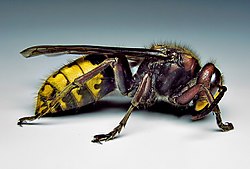| Revision as of 15:11, 7 October 2006 editRoboServien (talk | contribs)1,349 editsm robot Adding: nds-nl:Heurem← Previous edit | Revision as of 03:22, 8 October 2006 edit undoWidefox (talk | contribs)Autopatrolled, Extended confirmed users, Page movers, IP block exemptions, New page reviewers, Pending changes reviewers, Rollbackers107,074 edits rv vandalism to 04:41, 2 October 2006 Widefox , added subsequent editsNext edit → | ||
| Line 35: | Line 35: | ||
| * ''Vespa crabro caspica'' Pérez, 1910 | * ''Vespa crabro caspica'' Pérez, 1910 | ||
| * ''Vespa crabro chinensis'' Birula, 1925 | * ''Vespa crabro chinensis'' Birula, 1925 | ||
| ==Relationship with humans== | |||
| :{{dablink|Also see ]}}. | |||
| ==Stings== | ==Stings== | ||
| :{{dablink|Also see ]}}. | :{{dablink|Also see ]}}. | ||
| European hornets will defend their nest vigorously if disturbed. However, they generally try to avoid confrontations with humans when possible. | |||
| ==Group== | ==Group== | ||
Revision as of 03:22, 8 October 2006
| European Hornet | |
|---|---|

| |
| Female European Hornet | |
| Scientific classification | |
| Kingdom: | Animalia |
| Phylum: | Arthropoda |
| Class: | Insecta |
| Order: | Hymenoptera |
| Family: | Vespidae |
| Genus: | Vespa |
| Species: | V. crabro |
| Binomial name | |
| Vespa crabro L., 1761 | |
- Also see hornet. For the insect known colloquially in America as a hornet see Bald-faced hornet, and similarly for the Australian hornet.
The European hornet Vespa crabro is the largest European eusocial wasp. It is known commonly (and correctly) as a hornet. This is not to be confused with the colloquial use of hornet (although scientifically incorrect) for a Bald-faced hornet, or other aerial yellowjacket. The queen measures 25 to 35 mm long, males and workers are smaller. In males, the antennae have 13 segments, while females have 12. The male abdomen is composed of 7 visible segments, while that of the female has 6; females are equipped with an ovipositor.
Description
Eyes are deeply indented, shaped like a C. Wings are reddish-orange, the petiolated abdomen is orange striped with brown.
Geographic Colour Forms
European hornets worldwide are found with geographic colour forms :
- Vespa crabro crabro Linnaeus, 1758
- Vespa crabro vexator Harris, 1776
- Vespa crabro germana Christ, 1791
- Vespa crabro crabroniformis Smith, 1852
- Vespa crabro borealis Radoszkowski, 1863
- Vespa crabro oberthuri du Buysson, 1902
- Vespa crabro flavofasciata Cameron, 1903
- Vespa crabro altaica Pérez, 1910
- Vespa crabro caspica Pérez, 1910
- Vespa crabro chinensis Birula, 1925
Relationship with humans
- Also see hornet#Relationship_with_humans.
Stings
- Also see hornet#Stings.
Group
Hornets belong to the order or group Hymenoptera.
Notes
- V. Dubatolov, J. Kojima, J. M. Carpenter, A. Lvovsky (2003). "Subspecies of Vespa crabro in two different papers by Birula in 1925". Entomological Science. 6 (2003): 215–216.
{{cite journal}}: CS1 maint: multiple names: authors list (link) - J.M. Carpenter, J. Kojima (1997). "Checklist of the species in the subfamily Vespinae (Insecta: Hymenoptera: Vespidae)". Natural History Bulletin of Ibaraki University. 1 (1997): 51–92.
This insect-related article is a stub. You can help Misplaced Pages by expanding it. |